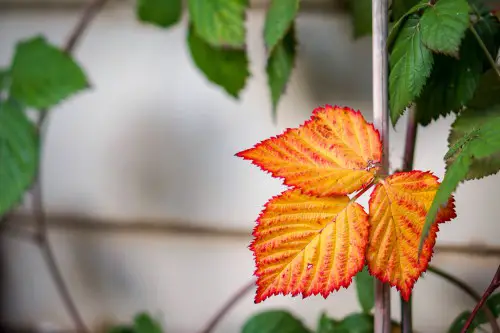Blackberry bushes are a common sight in many gardens and backyards, and they are known for producing delicious fruit. However, if you notice blackberry leaves turning brown, it could be a sign of an underlying issue.
Brown leaves can be a sign of stress, disease, pests, or nutrient deficiencies, and it’s important to address the problem promptly to prevent it from spreading.
Understanding why blackberry leaves turn brown is essential to nursing your plant back to health. There are several possible causes of brown leaves, including soil and watering conditions, nutrition and fertilization, and plant care and maintenance.
By examining each of these factors, you can determine the root cause of the problem and take steps to fix it.
Key Takeaways:
- Brown leaves on blackberry bushes can be a sign of stress, disease, pests, or nutrient deficiencies.
- Understanding the underlying cause of brown leaves is essential to nursing your plant back to health.
- Factors that can contribute to brown leaves include soil and watering conditions, nutrition and fertilization, and plant care and maintenance.
Related posts:
Understanding Blackberry Leaves Turning Brown
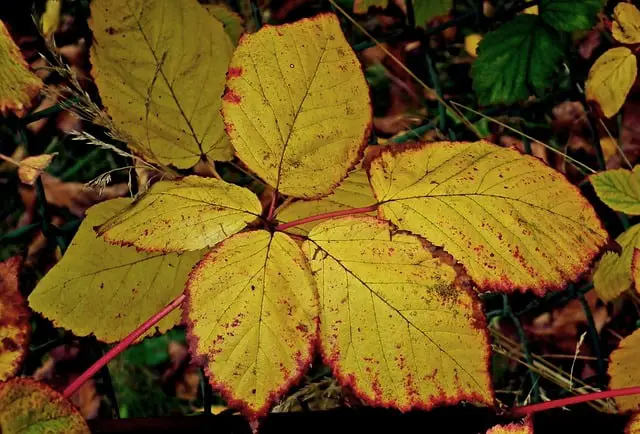
Blackberry leaves turning brown can be a cause for concern for many gardeners. Brown leaves can indicate a variety of issues, from overwatering to fungal diseases. In this section, we will explore the common causes of blackberry leaves turning brown, as well as how to prevent and treat this issue.
One of the most common reasons for blackberry leaves turning brown is overwatering. While blackberry plants require plenty of moisture to survive, too much water can lead to root rot and decay of established roots.
This can cause the leaves to turn brown and wilt. To prevent overwatering, ensure that the soil has proper drainage and avoid watering the plants too frequently.
Another reason for blackberry leaves turning brown is fungal diseases. Several diseases can cause blackberry leaves to turn brown, including blackberry rust, anthracnose, and cane blight.
Fungal diseases can be prevented by keeping the area free from weeds, removing and disposing of dead leaves and infected fruit, and avoiding overhead watering or misting of the plant.
In addition to overwatering and fungal diseases, blackberry leaves turning brown can also be caused by insect damage. Insects such as spider mites and aphids can cause discoloration and leaf damage, which can lead to brown leaves.
To prevent insect damage, keep the area free from weeds and debris, and use insecticides as needed.
Overall, blackberry leaves turning brown can be a sign of a variety of issues, from overwatering to fungal diseases and insect damage. By keeping the area free from weeds and debris, ensuring proper drainage, and using insecticides as needed, gardeners can prevent and treat this issue.
Blackberry Leaves Turning Brown – 4 Common Problems
Blackberry leaves turning brown can be a sign of various issues. Understanding the underlying cause is essential to nursing your blackberry bushes back to health. The causes of browning leaves can be classified into four sub-sections:
Disease and Fungal Infections, Pests and Insect Infestation, Environmental Factors, and Improper Care.
1. Disease and Fungal Infections
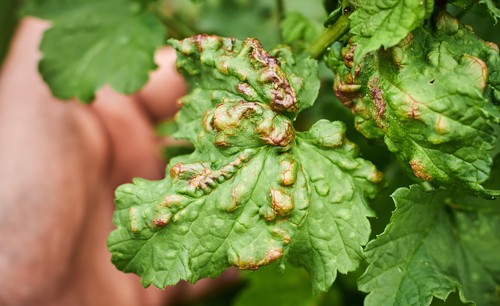
Blackberry bushes are susceptible to a variety of fungal diseases, including powdery mildew, orange rust, cane blight, and root rot. Powdery mildew is a common fungal disease that causes a white, powdery coating on leaves, stems, and fruit.
Orange rust is another fungal disease that causes orange spots on the leaves. Cane blight is a fungal disease that causes brown spots on the canes. Root rot is caused by a fungus that attacks the roots of the plant, leading to brown leaves and stunted growth.
2. Pests and Insect Infestation
Aphids, leafrollers, and spider mites are common pests that can cause blackberry leaves to turn brown. Aphids suck the sap from the leaves, causing them to wilt and turn brown.
Leafrollers are caterpillars that roll up the leaves, causing them to turn brown and dry out. Spider mites are tiny insects that feed on the leaves, causing them to turn brown and fall off.
3. Environmental Factors
Environmental factors can also cause blackberry leaves to turn brown. Overwatering, drought, heat stress, chemical stress, extreme temperatures, lack of light, humidity, and underwatering are all environmental factors that can cause blackberry leaves to turn brown.
Overwatering can lead to root rot, which can cause brown leaves and stunted growth. Drought can cause the leaves to dry out and turn brown. Heat stress and chemical stress can cause the leaves to turn brown and fall off.
Extreme temperatures can cause the leaves to wilt and turn brown. Lack of light can cause the leaves to turn yellow and then brown. Humidity can cause fungal diseases, which can cause the leaves to turn brown. Underwatering can cause the leaves to dry out and turn brown.
4. Improper Care
Improper care can also cause blackberry leaves to turn brown. Over-fertilizing can cause chemical stress, which can cause the leaves to turn brown and fall off. Underwatering and overwatering can both cause brown leaves.
Lack of pruning can cause the leaves to turn brown and fall off. Excessive heat and lack of light can also cause the leaves to turn brown and fall off.
Soil and Watering Conditions
Soil Quality

The quality of the soil plays a crucial role in the health of blackberry bushes. Blackberry bushes thrive in well-draining soil that is rich in organic matter. Clay soils can retain too much moisture, which can lead to root rot and brown leaves.
If the soil is too acidic, it can prevent the plant from absorbing necessary nutrients, leading to poor growth and brown leaves.
To ensure the soil is of good quality, it is recommended to add compost and mulch to the top of the soil. This will help to improve soil structure, retain moisture, and provide essential nutrients to the plant. It is also important to test the soil’s pH levels to ensure it is not too acidic.
Watering Practices
Watering practices are another essential factor to consider when dealing with blackberry bushes. Insufficient water can cause the plant to become stressed, leading to brown leaves. Overwatering or soil water buildup due to insufficient drainage is also a common cause of blackberry leaves turning brown.
To prevent overwatering, it is important to ensure that the soil has proper drainage. This can be achieved by adding organic matter to the soil, which can help improve soil structure and drainage. It is also recommended to water the plant deeply, but infrequently, to encourage deep root growth and prevent water buildup on the soil surface.
It is also important to note that blackberry bushes require full sun to thrive. If the plant is not getting enough sun, it may become stressed, leading to brown leaves.
Additionally, wind and salt buildup in the soil can also contribute to brown leaves, so it is important to ensure the plant is protected from strong winds and that the soil is not overly salty.
Nutrition and Fertilization
Fertilizer Use
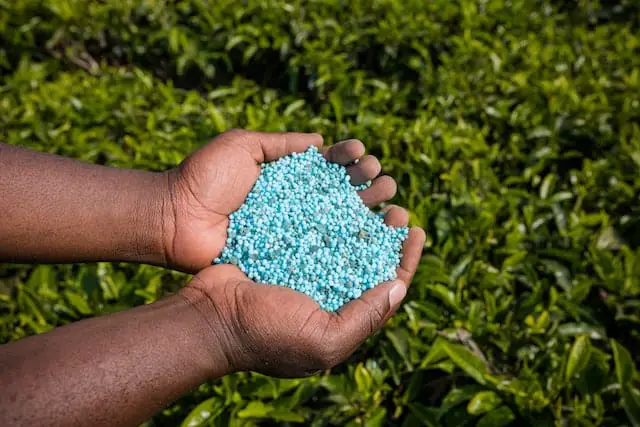
Blackberry bushes require a balanced fertilizer to thrive. Over-fertilizing can cause leaf burn and stunted growth. It is important to follow the recommended dosage on the fertilizer package. A balanced fertilizer, containing equal amounts of nitrogen, phosphorus, and potassium, is ideal for blackberry bushes.
It is recommended to apply fertilizer in the early spring before new growth begins. Additionally, it is important to apply fertilizer after the first harvest to ensure proper plant growth and fruit production.
Nutrient Deficiency
Nutrient deficiencies can cause brown leaves on blackberry bushes. Nitrogen deficiency can cause yellowing of leaves, while phosphorus deficiency can cause purple or reddish leaves. Magnesium deficiency can cause yellowing between leaf veins, while copper and manganese deficiency can cause brown spots on leaves.
To prevent nutrient deficiencies, it is important to provide blackberry bushes with proper nutrition. Applying compost or organic matter to the soil can provide natural sources of nutrients. Additionally, regular fertilization with a balanced fertilizer can help prevent nutrient deficiencies.
Plant Care and Maintenance
Blackberry bushes require proper care and maintenance to ensure healthy growth and prevent brown leaves. In this section, we will discuss pruning practices, location and sunlight, and repotting and transplantation to help you care for your blackberry bushes.
1. Pruning Practices
Pruning is an essential part of blackberry care. It helps remove dead or damaged canes and improves air circulation, which can prevent diseases. Pruning should be done in late winter or early spring before new growth begins.
To prune, remove all canes that have produced fruit in the previous year, leaving only new canes that are 1-2 years old. Cut the remaining canes back to around 3-4 feet in height, removing any weak or damaged growth. It is also important to remove any canes that are growing outside of the designated area.
2. Location and Sunlight
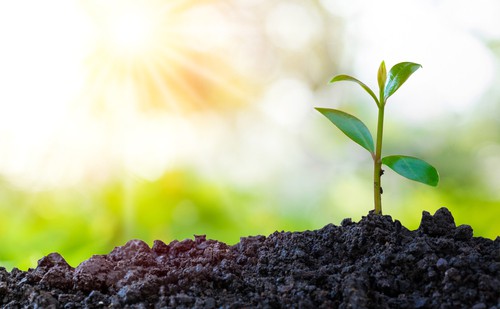
Blackberry bushes require full sun to grow and produce fruit. They should be planted in an area that receives at least 6-8 hours of sunlight per day. Improper sunlight can cause brown leaves and poor fruit production.
Blackberry bushes also require well-draining soil and air circulation to prevent root rot and other diseases. They should be planted in an area with good air circulation and not in a location that is prone to standing water.
3. Repotting and Transplantation
If you need to repot or transplant your blackberry bushes, it is best to do so in late winter or early spring before new growth begins. Choose a pot or planting location that is at least 18 inches in diameter and 18 inches deep to allow for proper root growth.
When transplanting, be careful not to damage the roots. Gently loosen the soil around the roots and lift the plant from the ground. Place the plant in the new location and fill in any gaps with soil. Water the plant thoroughly after transplanting.
Prevention and Treatment
Blackberry leaves turning brown can be caused by various factors, including disease, pests, and environmental and care adjustments. Preventing and treating these issues is critical to maintaining the health and productivity of blackberry bushes.
1. Disease Control
Blackberry rust and raspberry bushy dwarf virus are two common diseases that can cause brown leaves in blackberry bushes. To prevent these diseases, it is essential to practice good sanitation and remove any infected plant debris. Additionally, applying a fungicide, such as copper sulfate, can help control the spread of fungal diseases.
2. Pest Control
Insects, such as spider mites and aphids, can also cause blackberry leaves to turn brown. Using pesticides, such as organophosphates or chlorinated hydrocarbons, can be effective in controlling these pests.
However, it is important to use these products according to the manufacturer’s instructions and to avoid applying them during the plant’s dormant period.
3. Environmental Adjustments
Environmental factors, such as excessive watering or insufficient sunlight, can also contribute to brown leaves in blackberry bushes. To prevent overwatering, ensure that the soil is well-draining and avoid watering during periods of heavy rainfall.
Additionally, providing adequate sunlight and proper air circulation can help prevent fungal diseases.
4. Care Adjustments
Proper care, including fertilization and pruning, can also help prevent brown leaves in blackberry bushes. Applying a balanced fertilizer, such as a 10-10-10 formula, in early spring can provide the necessary nutrients for healthy growth.
Additionally, pruning the bushes to remove any dead or diseased branches can help prevent the spread of disease and improve air circulation.
Conclusion

In conclusion, blackberry leaves turning brown can be caused by a variety of factors, including overwatering, nutrient deficiencies, pests, diseases, and environmental stressors. It is important to identify the underlying cause of the browning leaves in order to properly treat the issue and prevent it from recurring in the future.
Proper care and maintenance of blackberry plants is essential to keeping them healthy and free from browning leaves. This includes regular watering, fertilization, pruning, and pest control. It is also important to monitor the plants for any signs of stress or disease and to take prompt action if any issues are detected.
In some cases, it may be necessary to consult with a professional horticulturist or arborist to properly diagnose and treat the issue. This can help ensure that the plants receive the proper care and attention they need to thrive and produce healthy, delicious fruit.
Overall, with proper care and attention, blackberry plants can be a rewarding addition to any garden or landscape. By taking the time to identify and address any issues with browning leaves, gardeners can help ensure that their plants remain healthy and productive for years to come.
Frequently Asked Questions
Why are the leaves on my blackberry bushes turning brown?
There are several reasons why blackberry leaves may turn brown. It could be due to fungal diseases such as Fusarium wilt or cane blight. It could also be a result of insect infestations, nutrient deficiencies, overwatering, or underwatering.
Why are my blackberry turning brown?
Blackberries can turn brown due to various reasons, including fungal diseases, insect infestations, nutrient deficiencies, overwatering, or underwatering. It is essential to identify the underlying cause to address the issue effectively.
How do you know if you are overwatering blackberry plants?
Overwatering can cause blackberry leaves to turn brown. You can tell if you are overwatering by checking the soil moisture level. Stick your finger into the soil up to the second knuckle. If the soil feels wet, do not water your plant. If it feels dry, it’s time to water your plant.
How do I get rid of brown spots on my blackberry leaves?
Brown spots on blackberry leaves could be due to fungal diseases. To get rid of the spots, remove the affected leaves and dispose of them. Make sure to sanitize your pruning tools after each use to prevent spreading the disease. You can also use fungicides to treat the plant.
How to bring a blackberry bush back to life?
If your blackberry bush is dying, there are a few things you can do to bring it back to life. First, prune the dead or diseased canes. Second, make sure the plant is getting enough water and nutrients.
Third, treat the plant with fungicides or insecticides if necessary. Finally, make sure the plant is getting enough sunlight.
What causes blackberry cane blight?
Blackberry cane blight is caused by the fungus Leptosphaeria coniothyrium. It affects the canes of the plant, causing them to turn brown and die.
The disease spreads rapidly, so it’s essential to remove the affected canes as soon as possible. Sanitize your pruning tools after each use to prevent spreading the disease.

Hey, I’m Lisa and I’ve been an avid gardener for over 30 years. I love writing, talking and living in the garden! Feel free to connect with me on my socials below

